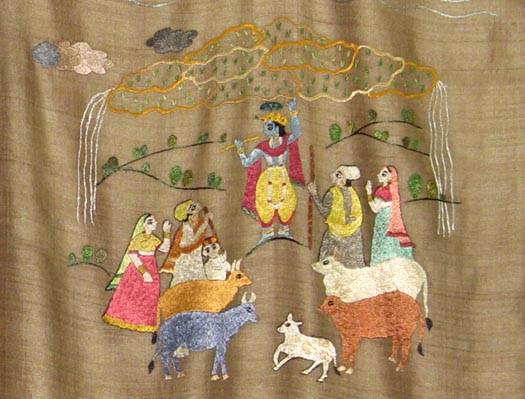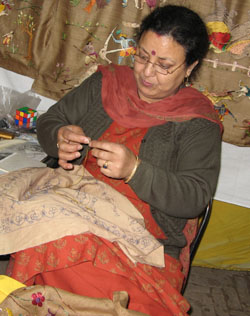Dec 06, 2025
Dec 06, 2025
The tales of Krishna, Ganesha and others are narrated in detail - or rather, in miniature detail. The threads of the story are embroidered with as much creativity as any vocal raconteur could evoke. But what is interesting in this traditional art of narrative is that scenes - such as those of the hunt or of Radha and Krishna - cannot be heard but only looked at.

For, these tales are narrated on embroidered square pieces of cloth - through the craft of the Chamba 'rumal' (square handkerchief), unique to the region of Chamba in Himachal Pradesh.
The Chamba 'rumal' sees the coming together of the talent of a miniature artist and the skill of an embroiderer. The miniature painter draws the theme on cloth, which is then painstakingly filled in by a woman embroiderer.
It is said that the Chamba 'rumal' can trace its strands to the time of Nadir Shah's invasion, when artists from Delhi fled to the Kangra Valley and eventually began what came to be known as the Kangra School of Painting. The work of the Kangra miniaturists is said to have inspired embroiderers, who created needle-embroidered images equivalent to the artistry of the paintings. The earliest pieces of the Chamba 'rumal' are said to be folkloric expressions that soon evolved into being embroidered representations of the Pahari miniature paintings.
Some accounts trace the origins of the Chamba 'rumal' to the 15th century, as the craft is referred to in Buddhist literature. Then there is a mention of Guru Nanak's sister, Bebe Nanki, having presented him with a beautifully embroidered rumal.
In the early days of the Chamba 'rumal', fine hand-woven muslin, or mul, from Punjab was embroidered with unbleached silk threads dyed in a variety vegetable colours. The 'rumals' were of varying sizes - from around 35 inches to 2 feet - and were remarkable for their detail and colour combinations. The larger pieces were used as wall hangings, while the smaller ones found use as gifts, tray mats or to wrap precious trinkets. The themes drew inspiration from mythology, with a distinct bias towards Radha and Krishna. Most Chamba 'rumal' patterns include a border of flowers or buttis (small motifs) - akin to a frame which completes the depicted scene.
The scene in itself captures expression and emotions to perfection. Above all, there is a certain flow to the entire piece, just as in a painting. For instance, a Raas Mandal would depict Krishna dancing, with the gopis in a circle, the embroidering of the dancing figures in a circle requiring considerable skill.
Amazingly, the smooth finesse of the embroiderer's double satin stitch makes it difficult to tell the wrong side from the right: the discerning eye has to rely on the position of the figures as indicators. Furthermore, the needlework begins with a backstitch and no knots are ever visible. Given this emphasis on detailing, it is not difficult to understand why there were few takers to make these expensive and time-consuming pieces or why there was a gradual decline in the patronage of this craft.
 Fortunately, the craft has seen a revival thanks to the keen interest shown by some, such as President's Award-winner Lalita Vakil, 54, who lives in Chamba. Recognised as a Master Craftsperson for excellence in Chamba Rumal embroidery in1993, Vakil learned the skill at the age of 14. It was already declining then, 35-odd years ago, but she had an excellent teacher: Maheshi Devi, herself a recipient of the President's Award in 1965. Vakil gradually created a unique market for the Chamba 'rumal'. Exhibiting her work and teaching girls purely on a voluntary basis to further the craft, she created greater awareness about this art.
Fortunately, the craft has seen a revival thanks to the keen interest shown by some, such as President's Award-winner Lalita Vakil, 54, who lives in Chamba. Recognised as a Master Craftsperson for excellence in Chamba Rumal embroidery in1993, Vakil learned the skill at the age of 14. It was already declining then, 35-odd years ago, but she had an excellent teacher: Maheshi Devi, herself a recipient of the President's Award in 1965. Vakil gradually created a unique market for the Chamba 'rumal'. Exhibiting her work and teaching girls purely on a voluntary basis to further the craft, she created greater awareness about this art.
What probably distinguishes Vakil's work from the countless others is her attention to detail and knowledge about both embroidery and paintings. She has developed new designs especially for different fabrics (traditionally the embroidery was done only on muslin) such as silk, tussar, voile etc. She also makes shawls, scarves (men), stoles so that they have contemporary utility. Referring to old designs and redrawing them, mix and match of existing old designs, and adding motifs has been her repertoire.
Vakil's will to experiment, launch new designs, hunt for old patterns to be reproduced, and desire to pore over history books to pick out new ideas is truly commendable. She is now experimenting with newer forms of depiction on coloured backgrounds. She ruefully adds, "Today's girls do not have the patience to work the entire piece. They want quicker results."
Another revivalist of the Chamba 'rumal' is the Delhi Crafts Council. The Council's project is an ongoing one. Though the seeds were sown way back in 1986, it materialised and took shape much later. New designs are being made, but the recreated pieces are being exhibited all over the country. Private collectors also procure reproduced pieces from them.
The Council has collated old pieces of Chamba rumals housed in various museums across the country such as the Indian Museum (Calcutta), National Museum (Delhi), Bhuri Singh Museum (Chamba), Calico Museum (Ahmedabad) and the Crafts Museum (Delhi). This effort has led to the creation of a database of over 100 old designs, which were recreated in the best manner by women embroiderers.
So, the next time you wish to hear a Raas Leela, watch Krishna's gopis dance amidst flowers, or be told another story from mythology, turn to a Chamba 'rumal' to capture the strands of the tale in detail.
17-Mar-2007
More by : Chitra Balasubramaniam